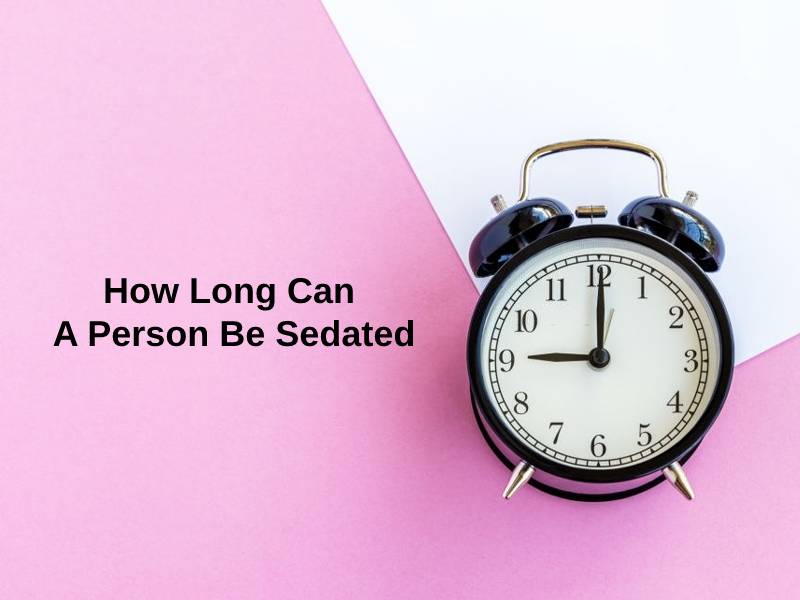Exact Answer: For as long as medically deemed necessary
Sedation refers to the controlled loss of consciousness in a patient. It is medically needed to treat different ailments and conditions. The chemical composition of a medical sedative essentially works to restrict the ability of a patient to respond to any external stimuli.
During various surgeries and procedures, such sedation becomes essential. Patients may also be sedated to reduce their anxiety levels. Thus, medical sedation is used to counter mental health issues in patients. There are various levels of sedation that are prescribed to a patient on the basis of the particular concern that is to be assuaged.

How Long Can A Person Be Sedated
There is no maximum upper limit to the sedation period of an individual. The definitive medical treatment route being pursued by a physician determines the exact time frame.
Certain procedures require shorter periods of sedation. For instance, dental procedures, endoscopies, etc. require lighter sedation. These procedures can be carried out with localized anesthetics or general anesthesia. In the event of using the latter, the patient is brought out of the sedative state within a short span of time.
Generally, the norm is to wean the patient off the sedative by the end of the procedure. Most of these procedures last for 1-2 hours. After the end of the procedure, the patient will be slowly weaned off the drug. Thus, the patient can be conscious within an hour’s time.
However, when deep sedation is used in the event of longer procedures or major surgeries, the time frame of remaining unconscious significantly increases. Most surgeries last for over 3 to 4 hours. In some cases, major surgeries can take as long as 20-40 hours. Thus, the patient remains sedated for this prolonged time frame.
Similarly, in the case of certain medical conditions like nervous breakdowns, pneumonia, and brain traumas, etc., the doctor may need to prescribe a certain period for maintaining the medically induced coma state. In such a situation, the patient cannot be weaned off the sedative until the condition of the individual improves according to the doctor’s parameters. In some cases, a patient is kept in a comatose state for up to several years.
In Summary:
| Need for Sedation | Time Under Sedation |
| Small Procedures | 1-2 hours |
| Major Surgeries | As long as the surgery lasts |
| Medical Conditions (like diseases or traumas) | As prescribed by the physician |
Why Can A Person Be Sedated For So Long?
The sedation method and the time frame will be hinged completely on the doctor’s specific orders. Several verticals like the age, gender, co-morbidities of the concerned patient are taken into consideration before formulating the plan to induce sedation.
Usually, a patient can be weaned out of sedation quite early during a marginal procedure because he/she is simply needed to remain unconscious for as long as the procedure lasts. Since most of these procedures are minor, they are completed well within a short period of time and the patient can regain consciousness shortly after they end.
On the other hand, for procedures that are longer like major surgeries, patients are needed to remain unconscious so as to not remember the trauma of the surgery. Longer periods of sedation help them remain isolated from the medical trauma of the various surgical steps. Deep sedation during long surgeries also helps patients remain ignorant of the pain of the procedure.
Patients are kept in medically induced comas for a prolonged time frame to help their bodies heal. This period can extend well into months and even years. Sometimes when a patient encounters a nervous breakdown, doctors put them in a coma to assuage their anxiety and help their brains gain the much-needed rest.
For such situations, special care has to be taken for the unconscious body like preventing bed sores and ulcers. Most patients can only be weaned out of sedation upon the doctor’s orders. Removing sedation without the doctor’s consent and approval can harm patients. It can also be traumatic for the patient in question.
Conclusion
Sedatives are strong and powerful drugs used under the authorization of doctors. They help make patients unconscious during medical procedures. However, their usage can only be regulated by the doctor in charge as he/she is well-versed with the patient’s medical history.
The total duration of sedation for any patient will be determined by the doctor. The sedation period varies greatly from one individual to another. Moreover, it is also important to remember that there are no upper limits to sedation. The doctor judges each medical situation differently and prescribes sedatives, if and when needed. Thus, it is his prerogative to decide on the right time to wean the patient out of the sedated state.





















Such an insightful read! The explanations about sedation duration are enlightening.
Absolutely, this article addresses an important aspect of medical procedures.
The focus on the reasons for prolonged sedation is thought-provoking.
It’s interesting to learn how different procedures and conditions influence the duration of sedation.
Agreed, it’s crucial to understand the medical reasons behind extended sedation periods.
A well-researched and thought-provoking post, shedding light on the intricacies of sedation duration.
This article provides a comprehensive understanding of the medical factors influencing sedation duration.
The article’s conclusion emphasizes the importance of doctor-authorized usage of sedatives, a critical point indeed.
I agree, the significance of medical supervision in sedation cannot be overstated.
The discussion on weaning out of sedation and the patient’s well-being adds depth to the article.
Indeed, the focus on the patient’s safety and healing process is highly informative.
Absolutely, the article offers valuable insights into patient care and recovery.
This article provides a practical and detailed overview of medical sedation. Well done!
I appreciate the clarity and depth of information presented in this article.
The emphasis on the patient’s safety and the doctor’s orders is commendable.
Absolutely, patient care and well-being should always be the top priority.
Very interesting content, the medical perspective on sedation duration is quite intriguing.
Very informative article, the details about the duration of sedation are quite helpful.
I agree, this article provides a comprehensive understanding of sedation.
An insightful and educational piece, highlighting the complexities of sedation duration.